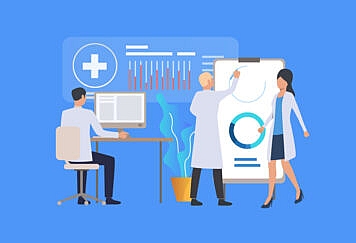Healthcare and digital technology are meeting now in ways that never would have been possible even ten years ago. The rise of telecommunication technology has made it easier than ever to gain access to doctors and nurses from the comfort of home.
The technology that makes this possible falls into a category known as “telehealth,” a resource that is at once increasing accessibility for patients while also helping hospitals to make the most of their often too-limited staff.
Naturally, in an age where hospitals and patients both are failing to get what they need when it comes to healthcare communication, this is an appealing possibility. But it also isn’t a perfect one. In this article, we take a look at what telehealth can do, and what should be left to traditional healthcare services.
First, Let’s Define Telehealth
Telehealth is any technology that allows patients to access healthcare remotely. Often, this happens through a specialized application. These tools let the patient take a look at their records, message their doctor’s office, and sometimes even take video conferences with a healthcare professional.
Though the interactions don’t always play out in real-time— it may take office hours, or even a full working day to answer a written message— they are generally thought to be easier than having a patient go into the hospital for a simple question.
Now that you understand the technology, let’s take a look at some pros and cons.
Pro: It Helps Hospitals Make the Most of Limited Resources
Last year, a nurse in Washington made national news for dialing 911. There wasn’t exactly an emergency taking place at the hospital in the way that there is pretty much always some type of emergency happening at most hospitals.
It wasn’t even an abnormally busy day. They just didn’t have enough nurses to handle what was actually a pretty average influx of patients. The dispatcher was able to send some help, but the incident drew more attention to a problem that was already well-known. Hospitals are dangerously understaffed.
Telehealth technology obviously doesn’t add more employees to the hospital’s staff but it does allow existing employees to cover more ground. A nurse can only see one patient at a time in the office, but on a telehealth app, they can answer many questions in a relatively short period of time.
While this may feel like an imperfect solution for a staffing-starved hospital, it can bridge a gap that would otherwise be unsolvable.
Cons: Telehealth Doesn’t Work for Everything
Naturally, there are certain situations that will require the patient to come into the doctor’s office. You can’t do a physical on a video call, and the same goes for lab work. However, though telehealth can’t replace these needs, it can allow hospitals to allot more time for them. Clearing out the more straightforward problems leaves more time for things that need to happen in person.
Pros: It Helps Reach People with Accessibility Issues
So much is made of the prohibitive cost of healthcare that it is sometimes forgotten there is a significant portion of the population who can afford to access care, but still can’t get to it. There are several reasons why this might be the case:
- They are immobile: It’s not so strange for a person who needs care to be physically unable to get to it because of their condition. While these people will still need to get to the hospital sometimes, it can improve their lives substantially to have a way to get simpler questions answered remotely.
- They lack transportation: Whether because of age, means, or personal choice, some people don’t have access to a car, or even public transportation. For them, coordinating a visit to the doctor’s office can be a complicated experience— one they might put off. Telehealth allows them to get some care from the comfort of their home.
- Geography: Finally, some hospital systems service enormous swaths of land. This is usually seen in rural settings where one hospital will treat an entire county. In these situations, it won’t make sense for the person to drive forty-five minutes each way just to ask a simple question. Telehealth technology eliminates that need.
While these people will still need to be physically present for certain aspects of their care, telehealth technology eliminates an accessibility barrier that otherwise might have kept them from interacting with the system at all.
Cons: It’s Still Not for Everyone
In some instances, telehealth trades one accessibility issue for another one. Many of the same people who can’t get to the hospital also can’t use an application that is designed to connect with it. The primary reason for this is known as the “digital divide”— a gap between people who have access to the internet, and those who do not.
Most people who struggle with accessibility do so for one of three reasons:
- Cost: An internet connection isn’t cheap. Families that are struggling to make ends meet may not be able to justify that expense.
- Age: While the number of people who are separated from digital technology by age is shrinking every day, there is still a significant portion of the elderly population who will not be capable of using an application to seek healthcare.
- Geography: Finally, location. Rural areas are mainly known for struggling to access the internet. It’s for the same reason that they often don’t have stable access to healthcare: size. Wi-Fi providers would need to make an enormous investment in infrastructure to properly service rural areas. They don’t do it because the return on the investment doesn’t justify the cost.
Unfortunately, there is no easy answer to any of these problems.
Pros: It Increases the Odds that Patients Will Take Preventative Care
Preventative care is often unappealing. It takes a lot of time, work, and money for a person to regularly visit the doctor. If they feel good, they might decide it’s not worth the effort. With telehealth technology, however, there isn’t very much effort to take.
It becomes very simple to get health-related insights and answers, increasing the odds that patients will take advantage of the system.
Follow TechStrange for more Technology, Business, and Digital Marketing News.





